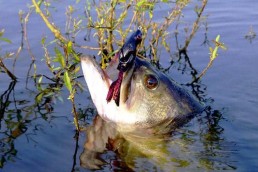July is the ‘Rat’ Time to Edge and Skim Thick Weeds
SHARE THIS POST
There are few angling experiences that I enjoy more than taking some good fish on topwater lures. Once the spring spawn has concluded and the fish are eager for sustenance, pike, largemouth and smallmouth bass, crappies and even rock bass seem eager to tangle themselves upon the treble hooks when they are hungry and aggressive.
The great thing about topwater fishing is that it continues throughout the summer and right into fall. Even though July and August are traditionally when weed growth is at its “ugliest”—with farm ponds and small lakes so weed-choked that normal angling methods seem impossible—the topwater bite can be very effective.
How can this be?
Are you enjoying this post?
You can be among the first to get the latest info on where to go, what to use and how to use it!
The answer is to fish parallel to the weed edges or right on top of them.
Very few bodies of water ever become completely weed-choked. As long as there are open pockets in the lake or pond, the fish can be caught. In these situations, I prefer to use some of the older baits such as the Jitterbug, the Hula Popper, the Smithwick Devil’s Horse, the Neal Spinner, the Rapala Original Floater and the Rebel Pop-R. Predators like largemouths lurk beneath the weed mats and patrol the outer edges searching for anything that appears to be edible. Plunk one of these lures down, wait for the ripples to subside and give it a twitch. If nothing happens, twitch it again, and then again. Barring an explosive strike that sounds like a watermelon rolling off a wagon and landing, and if there is enough water to do so, begin a slow, steady retrieve. When nothing happens and the edges of the weeds have been passed, flip the lure up out of the water and repeat the process. Any of these lures, even the Jitterbug, can be twitched in place. Even if no fish strike, believe me, at least one or two are watching.
MWO
SHARE THIS POST
Did you enjoy this post?
You can be among the first to get the latest info on where to go, what to use and how to use it!
John Bennett
John Bennett is a retired history teacher, historical re-enactor, father and grandfather. As a four-season outdoorsman, his passion is waterfowl hunting and fishing for smallmouth bass. He lives in Ohio and spends quite a bit of time in his primitive log cabin, which he built.


